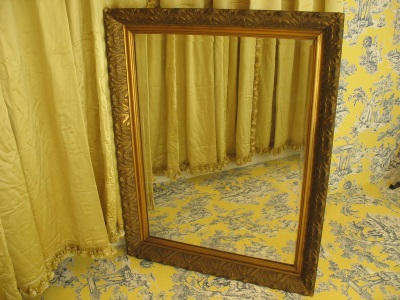 |
Mirror, mirror, on the wall …Mirrors are interesting things. However, they are often poorly described. Many texts bogusly refer to mirrors as devices that reflect an image, switching it left-right (stand in front of a mirror and wave your ‘right’ hand, and your chiral twin, seen in the mirror, waves their ‘left’ hand back at you). |
Mirrors are interesting things. However, they are often poorly described. Many texts bogusly refer to mirrors as devices that reflect an image, switching it left-right (stand in front of a mirror and wave your ‘right’ hand, and your chiral twin, seen in the mirror, waves their ‘left’ hand back at you).
Mirrors certainly do reflect images, but they do not reflect left-right, but instead do it front-back. It’s only because people* reference their limbs according to a local coordinate frame that this confusion arises. If, instead of relative descriptions like ‘left-right’, we used absolute terminology like North-South we’d see this. If you look directly at a mirror, facing North, and point with your ‘right’ hand out to the East, you will see that your image is also pointing East. It’s the directions in, and out, of the mirror that are inverted.
|All except a few very interesting Aboriginal tribes in Australia whose language has no concept of relative positions, just cardinal directions (even at a small scale). Can you imagine a conversation with these people? *“Could you pass me that cup please, it’s one on the table South of you!”, “Hey look at that interesting rock on the floor nine inches South West of your foot”. “Watch out, there’s a wild dog South East of your chair!”| |
|
Our first challenge today is to consider how big a mirror we might need to see ourselves. What is the shortest length mirror that allows a person to view their entire body? (We’re assuming that the mirror is wide enough to allow you to view the width of your body).
What is the shortest length mirror that allows a person to view their entire body?
We’re going to assume the mirror is a planar mirror (flat), and fixed to a vertical wall, and the wall is perpendicular to a flat floor.
Without thinking too deeply, you might be tempted to suggest that the mirror needs to be as tall as a person (since it reflects what it sees), or that it might depend on how far away the subject stands away from the mirror. As it happens, both of these are incorrect.
| |In the diagram on the left, imagine we are standing in front of a large mirrored wall. We can see a reflection of ourselves an equal distance away from the mirror.|
|
|In the diagram on the left, imagine we are standing in front of a large mirrored wall. We can see a reflection of ourselves an equal distance away from the mirror.|
| |Now, take a look at your foot in the reflection. The yellow line shows the ray of light.|
|
|Now, take a look at your foot in the reflection. The yellow line shows the ray of light.|
| |According to the Law of Reflection, the angle the incident ray makes with the normal is the same as the angle of the reflection ray.|
|
|According to the Law of Reflection, the angle the incident ray makes with the normal is the same as the angle of the reflection ray.|
| |The bottom of the foot is the lowest part of the our body we need to see. Any mirror below this is not needed.|
|The bottom of the foot is the lowest part of the our body we need to see. Any mirror below this is not needed.|
We can see there is a lower cut-off for the mirror, and we don’t need any mirror below this.
We can perform a similar thought experiment with looking at the top of our head.
| |We look at the top of our head in the image.|
|
|We look at the top of our head in the image.|
| |As before the reflected ray comes off the mirror at the same angle as the incident ray.|
|
|As before the reflected ray comes off the mirror at the same angle as the incident ray.|
| |Any mirror above this point is not needed.|
|Any mirror above this point is not needed.|
We can instantly see that the mirror does not need to be the same height as us to see our entire body, dispelling the first bogus suggestion.
If we think about this more, this makes complete sense. Because of the law of reflection, a person standing in front of a mirror only needs to look down halfway to their feet. Similarly, they only need to look up halfway to see the top of their head. If attached correctly, a mirror only needs to be half as tall as a person.

A mirror only needs to be half as tall as a person in order for them to be able to see their entire body!
To correctly mount this half-height mirror, it needs to be placed so that the top of the mirror is halfway between the eyes of the person and the top of their head!
Because of the law of reflection, it does not matter what these angles are (Or you can convince yourself the triangles to of the rays to the mirror are similar to those to the virtual image). This means that it does not matter how far away you stand from the mirror; you will still be able to see your entire body.
Here’s the second challenge: What happens to the the size of your reflection as you move further away from a mirror?
Here’s a thought experiment. Below is a video I took with my smart phone at eye level. I’m looking into a 12” square planar mirror (actually a mirror tile purchased at a local hardware store. Just a couple of dollars for half a dozen. What a bargain!)
Using a marker I’ve drawn two horizontal lines framing my face. These will help give reference.
When the video starts, I’m going to slowly back away from the mirror, keeping the phone at eye level. What will happen to my face relative to the two black horizontal lines marked a fixed distance apart onto the surface of the mirror? Think about it before you play the video.
What will happen to the size of my reflection as I back away from the mirror?
Did that surprise you? The size of my face did not change! It remained the same size, as can be seen by the fixed marks on the mirror. In fact, even as I moved backwards and forwards, what was in frame stayed the same (the top of my head, elbows, wrists, shoulders …)
This might seem paradoxical at first; you might have thought that, as I moved further and further away from the mirror, that you might be able to see more and more of my body, and that I’d get smaller. That’s not the case. Again, using simple ray tracing we can see why.

Because of the law of reflection, the angle of incident and reflection into the eye (or camera in this case), remain the same.
No matter how near, or far away from, the mirror your eye is, the angles mean that the size of the image on the mirror remains the same size.
What does seem paradoxical is that, if you mark the height of yourself on the mirror, then measure this, you’ll find out that the height of this image is half your height! The mirror isn’t reflecting you 1:1, it’s showing you an image of yourself half the your real size! (But you are looking at a virtual image that is twice as far away from you than you are in front of the mirror to compensate).
From this article we’re learned four important things that I hope you’ll remember every time you stand in front of a mirror:
-
To see your entire body in a mirror, the mirror only needs to be half your height.
-
To mount this mirror correctly, ensure that the top edge is placed at a height halfway between your eyes and the top of your head.
-
It does not matter how far away you stand from a mirror; your reflection will still show the same amount of your body.
-
The size of your image in the mirror is half the size you are in real life!
Of course, if you are a vampire, all bets are off!
